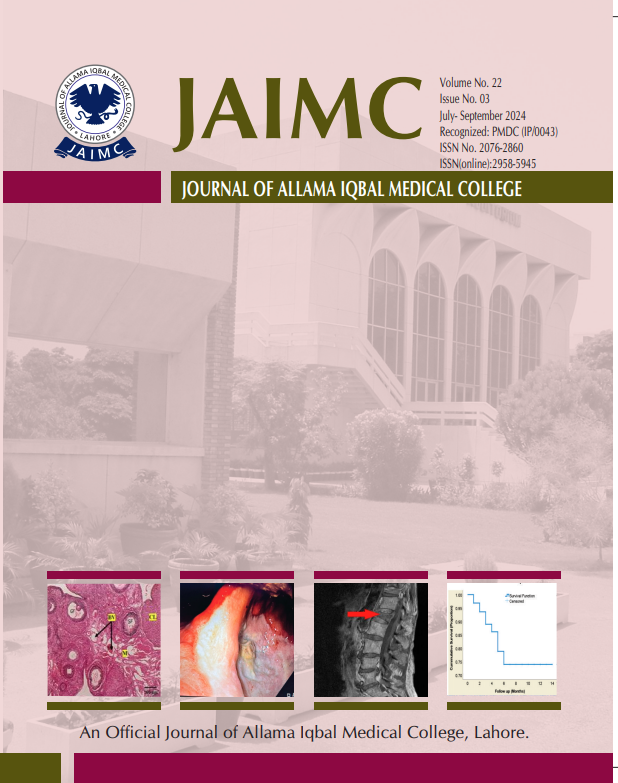Comparative Study of Short Segment Fixation with or Without Transpedicular Bone Graft for Surgical Treatment of Burst Fractures of Thoracic & Lumbar Spine in Adults After Trauma
DOI:
https://doi.org/10.59058/7yenjy83Keywords:
Anterior vertebral height, Kyphotic Angle, Short segment fixation, Trans pedicle graft substitutes,Trans pedicle screw fixation, Thoracolumbar Burst fracturesAbstract
Background And Objective: Thoracolumbar fractures are among the most common fractures of the spine because of high energy trauma. A short segment fixation with two proximal & two distal screw fixation including the fractured vertebra at single level thoracolumbar fracture with or without transpedicular intracorporeal bone graft provides the adequate support & stability. The objective of this study was to assess the clinical effectiveness of short segment fixation with or without transpedicular bone grafting substitutes in patients with single level Thoracolumbar spine Burst fracture.
Methods: This Randomized Controlled Trial was conducted from December 2016 to December 2019 in the Department of Orthopedic & Spine Surgery at Lahore General Hospital, Lahore. After approval from Hospital Ethical Review Board, 64 patients having single level burst fractures of thoracolumbar Spine were divided into two equal groups A & B. In Group A, all patients were treated with short segment trans pedicle screw fixation with bone graft while in group B patients, only short segment fixation was done. All the patients were followed for one year to assess the Kyphotic angle, vertebral body height and visual analogue score (VAS) and was noted in a predesigned proforma.
Results: Group A and Group B demonstrated statistically significant differences in various measured outcomes. For the kyphotic angle, Group A recorded a mean of 18.5° ± 4.0°, while Group B had a slightly higher mean of 19.5° ± 4.2° (p = 0.03). Vertebral height measurements revealed that Group A maintained a mean height of 23.1 ± 2.8 mm, whereas Group B exhibited a lower mean height of 21.3 ± 3.3 mm (p = 0.02). Lastly, the VAS score, reflecting pain intensity, showed Group A with a mean score of 2.0 ± 0.8, slightly lower than Group B's 2.05 ± 0.7 (p = 0.01), indicating a statistically significant improvement in pain levels in both groups but more significant in Group A over the year.
Conclusion: Short Segment Fixation is an effective treatment option for maintaining the anterior vertebral height and prevention of loss of kyphotic angle at single level thoracolumbar fracture of the spine. Moreover, the VAS score was also improved where the short segment fixation with transpedicular bone graft was done.
Key Words: Anterior vertebral height, Kyphotic Angle, Short segment fixation, Trans pedicle graft substitutes,Trans pedicle screw fixation, Thoracolumbar Burst fractures
Downloads
Published
Issue
Section
License

This work is licensed under a Creative Commons Attribution-NonCommercial-NoDerivatives 4.0 International License.
You are free to:
- Share — copy and redistribute the material in any medium or format
- The licensor cannot revoke these freedoms as long as you follow the license terms.
Under the following terms:
- Attribution — You must give appropriate credit , provide a link to the license, and indicate if changes were made . You may do so in any reasonable manner, but not in any way that suggests the licensor endorses you or your use.
- Non-Commercial — You may not use the material for commercial purposes .
- No-Derivatives — If you remix, transform, or build upon the material, you may not distribute the modified material.
- No additional restrictions — You may not apply legal terms or technological measures that legally restrict others from doing anything the license permits.
Notices:
You do not have to comply with the license for elements of the material in the public domain or where your use is permitted by an applicable exception or limitation .
No warranties are given. The license may not give you all of the permissions necessary for your intended use. For example, other rights such as publicity, privacy, or moral rights may limit how you use the material.


